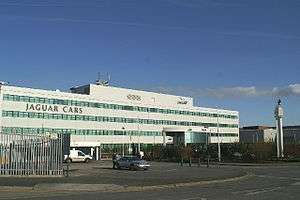Halewood Body & Assembly
 | |
| Built | 2 October 1963 |
|---|---|
| Location | Halewood, Merseyside, England |
| Coordinates | 53°20′54″N 2°49′58″W / 53.34833°N 2.83278°W |
| Industry | Automotive |
| Products | Automobiles |
| Employees | 4,000 |
Halewood Body & Assembly is a Jaguar Land Rover production facility in Halewood, Merseyside, England.
History
1963–2001
Halewood was originally opened by Ford Motor Company on 2 October 1963, to build the then small-saloon sized Ford Anglia. Reflecting pressure on Ford of Britain's principal plant at Dagenham, the Halewood plant was also used for assembling the Ford Corsair between the model's 1964 launch and 1969.[1]
More recently the Halewood plant has been associated with the Ford Escort - which replaced the Anglia in 1967. The Capri was also assembled at Halewood from its introduction in 1969. The introduction of the Fiesta in 1976 saw Ford of Europe restructure its entire European operations: all Capri production was moved to the Cologne plant in Germany, whilst Halewood was developed to become (until 1998 along with Saarlouis) Ford's main European production facility for the Escort and derivative Ford Orion models.
The Escort was phased out by Ford in 2000, but the van version of the Escort remained in production at Halewood on a small scale until 2002 when it was replaced by the Turkish built Transit Connect.
Since 2001
In 1997, Ford announced plans to replace the Escort with the more radically styled Ford Focus. Furthermore, Ford of Europe announced European production of the Focus would only be carried out at Saarlouis, Germany and Valencia, Spain fuelling rumours that Halewood was due to be closed by Ford. However, Jaguar Cars, owned at the time by Ford, was developing a new mid-sized saloon model which was loosely based on the Ford Mondeo. Ford decided that production of this model, the Jaguar X-Type, would commence at Halewood from 2001 onwards.
In 2007, Halewood commenced production of the second generation Land Rover Freelander model, Freelander 2, and a dirt track test facility was constructed at Halewood specifically for Freelander 2 and subsequent Land Rover models.
In March 2008, Ford finalised a deal to sell Jaguar and Land Rover to Tata Motors, part of the Indian-based Tata Group, one of the world's largest manufacturers of commercial vehicles. Under the terms of the deal, Ford retained ownership of Halewood's transmission plant which it operates in collaboration with Getrag.
On 15 July 2009, Jaguar Land Rover announced that it would cease production of the X-Type at the end of 2009, with the loss of 300 jobs, and have a three-week shut down between September and December of that year.
On 11 March 2010, the UK Government announced a £27 million grant was to be made available to Jaguar Land Rover for the production of an all-new model, the Range Rover Evoque, subject to the condition it is manufactured at Halewood. In July 2011, production of the Range Rover Evoque started. The Evoque became a best-seller, and was critically acclaimed for its concept-car-like styling. Soon, Jaguar Land Rover raised the number of employees to 3,000, due to the high demand for the Evoque. In early 2012, Jaguar Land Rover announced that they would employ an additional 1,000 staff for Halewood, to meet demand for the Evoque. In August of that year the plant switched to 24-hour running in order to meet demand.[2]
On 19 June 2014, JLR as announced an investment of £200M at Halewood, enabling the launch in 2014 of the new Land Rover Discovery Sport, the first member of an all-new family of Discovery vehicles.[3]
Current Products
- Range Rover Evoque (2011–present)
- Land Rover Discovery Sport (2015-present)
Former Products
- Ford Anglia (1962–1967)
- Ford Corsair (1964–1969)
- Ford Escort (1967–2000)
- Jaguar X-Type (2000–2009)
- Land Rover Freelander 2 (2006–2014)
References
- ↑ "News and Views: Corsairs to Dagenham". Autocar. Vol. 131 (nbr 3844). 7 August 1969. p. 13.
- ↑ Jaguar Land Rover Halewood plant in 24-hour production
- ↑ http://economictimes.indiatimes.com/industry/auto/automobiles/tata-motors-owned-jlr-announces-200-mn-pounds-investment-at-halewood-plant/articleshow/36816841.cms